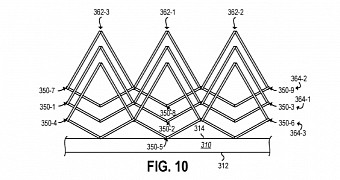Foldable smartphones are the next big thing of the mobile industry, and so far, tech giants Samsung and Huawei have already announced their products, while rival Apple is expected to follow with a similar iPhone model in the coming years.
While Microsoft is no longer involved in the hardware mobile industry after giving up on building Windows phones, the company is still working on a series of technologies that could at some point make sense on its Surface lineup of devices as well.
And because foldable screens are also expanding to laptops and 2-in-1s, Microsoft investing in this market category isn’t necessarily surprising.
A recent patent called “Moveable display supports, computing devices using same, and methods of use” (spotted by WU) details what is a technology developed by Microsoft that could help prevent display creases.
Foldable Surface?
Redmond’s method relies on two different approaches, both of which use movable display supports that could limit the bent radius to prevent creases. From the patent:
“In one implementation, a computing device is described. The computing device includes a flexible display including a thin film transistor matrix having a front surface and a back surface. A moveable display support is included and is connected to the back surface of the display and is configured to limit bending in one direction to a first bend radius while maintaining strain on the thin film transistor matrix below a predetermined amount of strain by elongating the moveable display support during bending.
In another implementation, a computing device is described. The computing device includes a flexible display having a front surface and a back surface. The computing device includes a moveable display support connected to the back surface of the display. The moveable display support is formed by a plurality of unit cells.”
Needless to say, this is a technology that’s still in patent stage, so there’s no guarantee it would ever make its way to the market. But Microsoft developing such tech is an indication that the company doesn’t want to be late to the foldable display party, and sooner or later, Surface models using these screens could go live too.

 14 DAY TRIAL //
14 DAY TRIAL //